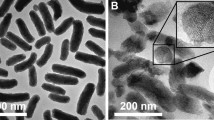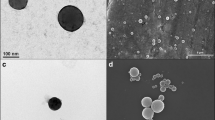Abstract
Purpose
Gastrointestinal deposition of nanoparticles was examined after oral administration to mice suffering from an experimental gastric ulcer model. Local drug delivery could reduce side effects and would be a distinct improvement compared to existing therapeutic approaches, e.g. in the local therapy of Helicobacter pylori.
Methods
A gastric ulcer was induced to Swiss mice by acetic acid injection. Fluorescent polystyrene particles with a nominal size of 50, 200, and 750 nm were administered orally for 3 or 5 days and particle adhesion in the gastrointestinal tract analyzed.
Results
In the ulcerated regions, an enhanced particle adhesion was observed compared to healthy controls. A size dependency of the deposition was found which further increased with a prolonged treatment period. For 750 nm particles only fair adhesion was observed (control, 2.0 ± 1.4%; ulcer, 4.5 ± 0.7% of daily administered particle mass), while already 200 nm particles showed higher binding (control, 2.9 ± 1.3%; ulcer, 7.8 ± 1.2%). Highest relative adhesion was found for 50 nm particles (control, 2.8 ± 1.3%; ulcer, 10.0 ± 1.5%). The targeting index of gastric ulcer versus healthy control was nearly constant around 2 after 3 days treatment, but increased distinctly for smaller particles after 5 days.
Conclusions
The use of sub-micron sized carriers holds promise for the targeted delivery of drugs to the ulcerated mucosal areas in the stomach.





Similar content being viewed by others
References
J. E. Crabtree. Immune and inflammatory responses to Helicobacter pylori infection. Scand. J. Gastroenterol. Suppl. 215:3–10 (1996). doi:10.3109/00365529609094526.
P. Correa. Helicobacter pylori and gastric carcinogenesis. Am. J. Surg. Pathol. 19(Suppl 1):S37–S43 (1995).
Y. Tabata, and Y. Ikada. Phagocytosis of polymer microspheres by macrophages. Adv. Polym. Sci. 94:107–141 (1990). doi:10.1007/BFb0043062.
A. Lamprecht, U. Schäfer, and C. M. Lehr. Size dependent targeting of micro- and nanoparticulate carriers to the inflamed colonic mucosa. Pharm. Res. 18:788–793 (2001). doi:10.1023/A:1011032328064.
A. Lamprecht, N. Ubrich, H. Yamamoto, U. Schäfer, H. Takeuchi, P. Maincent, Y. Kawashima, and C. M. Lehr. Biodegradable nanoparticles for the targeted drug delivery in the treatment of inflammatory bowel disease. J. Pharmacol. Exp. Ther. 299:775–781 (2001).
A. Lamprecht, H. Yamamoto, H. Takeuchi, and Y. Kawashima. Nanoparticles enhance therapeutic efficiency by selectively increased local drug dose in experimental colitis in rats. J. Pharmacol. Exp. Ther. 315:196–202 (2005). doi:10.1124/jpet.105.088146.
R. B. Umamaheshwari, S. Ramteke, and N. K. Jain. Anti-Helicobacter pylori effect of mucoadhesive nanoparticles bearing amoxicillin in experimental gerbils model. AAPS PharmSciTech. 5:E32 (2004). doi:10.1208/pt050232.
K. Dillen, C. Bridts, P. Van der Veken, P. Cos, J. Vandervoort, K. Augustyns, W. Stevens, and A. Ludwig. Adhesion of PLGA or Eudragit/PLGA nanoparticles to Staphylococcus and Pseudomonas. Int. J. Pharm. 349:234–240 (2008). doi:10.1016/j.ijpharm.2007.07.041.
Y. I. Jeong, H. S. Na, D. H. Seo, D. G. Kim, H. C. Lee, M. K. Jang, S. K. Na, S. H. Roh, S. I. Kim, and J. W. Nah. Ciprofloxacin-encapsulated poly(DL-lactide-co-glycolide) nanoparticles and its antibacterial activity. Int. J. Pharm. 352:317–323 (2008). doi:10.1016/j.ijpharm.2007.11.001.
J. E. Krawisz, P. Sharon, and W. F. Stenson. Quantitative assay for acute intestinal inflammation based on myeloperoxidase activity. Gastroenterology. 87:1344–1350 (1984).
M. Demoy, J. P. Andreux, C. Weingarten, B. Gouritin, V. Guilloux, and P. Couvreur. Spleen capture of nanoparticles: influence of animal species and surface characteristics. Pharm. Res. 16:37–41 (1999). doi:10.1023/A:1018858409737.
S. Okabe, and K. Amagase. An overview of acetic acid ulcer models—the history and state of the art of peptic ulcer research. Biol. Pharm. Bull. 28:1321–1341 (2005). doi:10.1248/bpb.28.1321.
G. P. Morris, P. L. Beck, M. S. Herridge, W. T. Depew, M. R. Szewczuk, and J. L. Wallace. Hapten-induced model of chronic inflammation and ulceration in the rat colon. Gastroeneterology. 96:795–803 (1989).
G. Yue, F. F. Sun, C. Dunn, K. Yin, and P. Y. K. Wong. The 21-aminosteroid tirilazad mesylate can ameliorate inflammatory bowel disease in rats. J. Pharmacol. Exp. Ther. 276:265–270 (1996).
M. P. Desai, V. Labhasetwar, G. L. Amidon, and R. J. Levy. Gastrointestinal uptake of biodegradable microparticles: effects of particle size. Pharm. Res. 13:1838–1845 (1996). doi:10.1023/A:1016085108889.
P. U. Jani, G. W. Halbert, J. Langridge, and A. T. Florence. The uptake and translocation of latex nanospheres and microspheres after oral administration to rats. J. Pharm. Pharmacol. 41:809–821 (1989).
P. U. Jani, G. W. Halbert, J. Langridge, and A. T. Florence. Nanoparticle uptake by the ratgastrointestinal mucosa: quantitation and particle size dependency. J. Pharm. Pharmacol. 42:821–826 (1990).
S. Sakuma, R. Sudo, N. Suzuki, H. Kikuchi, M. Akashi, and M. Hayashi. Mucoadhesion of polystyrene nanoparticles having surface hydrophilic polymeric chains in the gastrointestinal tract. Int. J. Pharm. 177:161–172 (1999). doi:10.1016/S0378-5173(98)00346-9.
S. K. Lai, D. E. O’Hanlon, S. Harrold, S. T. Man, Y. Y. Wang, R. Cone, and J. Hanes. Rapid transport of large polymeric nanoparticles in fresh undiluted human mucus. Proc. Natl. Acad. Sci. 104:1482–1487 (2007). doi:10.1073/pnas.0608611104.
B. Tirosh, and A. Rubinstein. Migration of adhesive and nonadhesive particles in the rat intestine under altered mucus secretion conditions. J. Pharm. Sci. 87:453–456 (1998). doi:10.1021/js9703380.
R. Nagashima. Mechanisms of action of sulcrafate. J. Clin. Gastroenterol. 3:117–127 (1981).
M. Polakovic, T. Görner, R. Gref, and E. Dellacherie. Lidocaine loaded biodegradable nanospheres. II. Modelling of drug release. J. Control. Release. 60:169–177 (1999). doi:10.1016/S0168-3659(99)00012-7.
B. Moulari, D. Pertuit, Y. Pellequer, and A. Lamprecht. The targeting of surface modified silica nanoparticles to inflamed tissue in experimental colitis. Biomaterials. 29:4554–4560 (2008). doi:10.1016/j.biomaterials.2008.08.009.
D. Pertuit, B. Moulari, T. Betz, A. Nadaradjane, D. Neumann, L. Ismaïli, B. Refouvelet, Y. Pellequer, and A. Lamprecht. 5-amino salicylic acid bound nanoparticles for the therapy of inflammatory bowel disease. J. Control. Release. 123:211–218 (2007). doi:10.1016/j.jconrel.2007.08.008.
Acknowledgements
Alf Lamprecht is grateful to the “Institut Universitaire de France” for the financial support. The project was co-financed by the Region of Franche-Comté (grant VJ000610).
Author information
Authors and Affiliations
Corresponding author
Additional information
An erratum to this article can be found at http://dx.doi.org/10.1007/s11095-009-9872-8
Rights and permissions
About this article
Cite this article
Hasani, S., Pellequer, Y. & Lamprecht, A. Selective Adhesion of Nanoparticles to Inflamed Tissue in Gastric Ulcers. Pharm Res 26, 1149–1154 (2009). https://doi.org/10.1007/s11095-009-9834-1
Received:
Accepted:
Published:
Issue Date:
DOI: https://doi.org/10.1007/s11095-009-9834-1




